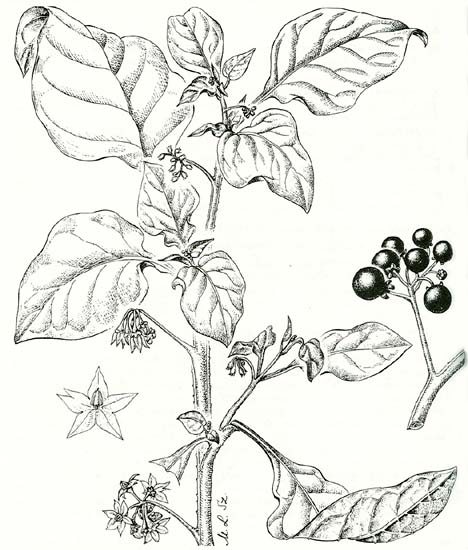
Synonymy
Solanum scabrum Mill., Gard. Dict. 8th ed. Solanum no. 6 (1768).
T: Cultivated Chelsea Physic Garden, origin North America, Miller s.n.; lecto: BM.
Description
Coarse annual or short-lived perennial herb to 1 m tall, glabrous or sparsely pubescent with simple, appressed, curved non-glandular hairs; prickles absent.
Leaves usually ovate, the lamina 7-12 (-16) cm long and 5-8(-14) cm wide, concolorous, entire or sinuate; petiole 1.5–7 cm long, narrowly winged in upper portion.
Inflorescence simple or sometimes branched, (6-)9–12 (-27)–flowered; peduncle 2–3(-6) cm long; pedicels 5-10 mm long. Calyx 1.5–3.5(-4.5) mm long. Corolla stellate, 15–20 mm diam., white, sometimes tinged purple and with yellow/green basal star. Anthers 2.5-3.5 mm long, oblong, brown.
Berries globular, 10–17 mm diam., purple-black, 4-10 per inflorescence; fruiting pedicels erect, adhering to fruit. Seeds 1.8–2.2 mm long, pale or stained purple. Stone cell granules absent. n=36.
Distribution and ecology
Occasionally cultivated but not known to be naturalised.
Its origins are uncertain - Linnaeus attributed it to Africa (as Solanum nigrum var. guineense L., Sp. Pl. 186 (1753)), while the type of the species comes from North America.
Common name
Huckleberry, Garden Huckleberry
Relationships
Part of the S. nigrum or "Black nightshade" group of species, usually referred to as cosmopolitan weeds and usually thought to have originated in the Americas. They are characterised by their lack of prickles and stellate hairs, their white flowers and their green or black fruits arranged in an umbelliform fashion.
The species can be difficult to distinguish. Other species to occur in Australia are S. americanum, S. chenopodioides, S. furcatum, S. douglasii, S. opacum, S. physalifolium, S. retroflexum, S. sarrachoides, S. nigrum and S. villosum.
A useful reference to the Black Nightshades is J. M. Edmonds & J. A. Chweya, The Black Nightshades. Solanum nigrum and its related species. Int. Plant. Genetic Res. Inst. Rome (1997).
Apparently not a particularly important food plant but in African countries the large berries are eaten as well as the leaves. The latter are often used as a vegetable or pot herb (see J. M. Edmonds & J. A. Chweya as cited above).
Notes
Some members of the complex have long been important food and medical sources in parts of Africa,
References: Keller, G.B. (2004). African nightshade, eggplant, spiderflower et al. - production and consumption of traditional vegetables in Tanzania from the farmer's point of view. MSc dissertation,
From the web
One of the edible African nightshades - a fact sheet about growing this plant in Africa can be downloaded at http://www.avrdc.org/LC/indigenous/sscabrum.html
A comprehensive fact sheet on S. scabrum in
Information on S. scabrum and its uses can also be found on the Plants for a Future site.
Further information, images and links for this species can be found on the Solanaceae Source site.